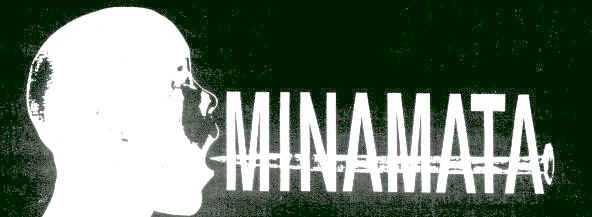

A sea bird falls suddenly from the sky. Fishermen and cats
die of a dancing disease. Men and women in business suits
march to the testimony of an expert witness healding a new
system. Gold coins shower down in atonement. A dead man
remembers his grandmother's farm. Snowfalls; the "Beverly
Hillbillies" theme is sung in Japanese; a child wants to ride the
ferris wheel; three trees are suspended in midair.
"Our life is a nothing but a continuous succession of
opportunities for survival.'
"Minamata is a fishing slash factory town in Japan. Perhaps
you've seen the pictures. They involve mercury poisoning.
Very aesthetic I guess. Life Magazine. Late sixties. But pictures
are symbls. And through pictures information becomes
symbols. Symboles are forgettable. Aesthetic. This play
wanits to be more than aesthetic. It wants to be more than
about some crazy diseased cats and Japanese people. It
wants to be more. It gets confusing."
MINAMATA Music, dance,
language, magic. A theatrical
tapestry of ever-shilfting visual and aural images. Threaded
through are themes of social responsibility, mutation, fate, the
deterioration and sacrifice of essential human and global
elements, the mechanized search for increasingly effecient
systems and the insidious corruption of material compensations.
Music for "Minamata"
by Fredric Myrow, composer
An African Pygmy chant is joined by a blues tune about a
shrinking woman. Fragments of themes evocative of Bach, an Italian
circus, cinema noir weave around each other. Chords from
the opera "Wozzeck" form the harmony with R&B rhythms in a song
about the Hyppocratic oath. Synthesized factory sounds eat up an
orchestral finale. A gospel song about a dead man is counter-
pointed with "I've Got a Crush on You."
The music has evolved as an integral part of the theatrical
narrative, parallel, the text in its references to widely diverse
sources and cultures. The result of a close collaboration, all
elements of text, image, movement and music are orchestrated to
function symphonically -- as parts of a single theatrical/musical
reality
Minamata: Chronology of a
Tragedy
by Michael Hart Jondreau
In 1907, the factory called Shin Hihan Chisso, or just
Chisso, brought industry to Minamata, a village on the southern-
most Japanese island of Kyushu. It was soon poisoning the sea.
As early as 1925, in a furiously industrializing Japan, Chisso
paid fishermen for damage to fish.
Then as Japan struggled for industrial power, two separate
events set the scene for tragedy in the town. Chisso began the
manufacture of acetaldehyde a process which required methylmer-
cury. And then in the late 1940s, the factory turned its waste
discharges from the broad sea to Minamata Bay.
An estimated 220 tons of mercury were boldy dumped into the
bay between 1949 and 1953, and into the bodies of the fishing
families of the village.
Methylmercury is organic mercury. It readily finds perma-
nent places in the brain and spinal cord, the nerves and the
organs. It was the violent death of cats in the early 1950s that
gave hints of Minamata disease the mercury poisoning from the
sea. People called it "Cat's Suicide," and "Cat's Dancing
Disease," as the animals went screaming, treading spastically,
salivating, and flinging themselves into the bay.
The cats, of course, were fisheaters.
Minamata disease is mercury, poisoning. It is a man-made
disease. It is a disease of industrial pollution. The victims
experience the misery of nerve damage, sometimes over many years.
The victims are all ages; some are stricken before birth.
Depression and excitability appear as early signs. But when the
fishermen first noticed the signs, they kept it to themselves.
They felt guilty. They thought the drunken walk and slurred
speech were signs of some kind of contagion.
In April of 1956, Mrs. Watanabe brought her six-year-old
daughter into the hospital of the Chisso factory. This incident
brought to light more victims of the "unclarified disease," to
quote the examining doctor, Dr. Hosokawa.
It was Hosokawa and his laboratory cat tests, that proved
the connection between methylmercury and Minamata disease. But
Hosokawa worked for the Chisso company, and he held back his
evidence until the trial many years later.
A trial was finally brought about by desperate victims and
their families amid deep emotion from all sides, including many
citizens who were against the victims. Chisso factory workers
violently defended their company. The government took sides,
saying the issue was closed after small payments were made to the
victims by Chisso in 1960.
Chisso was proven to be discharging mercury into Minamata
Bay in 1962 by a university research team. But not until 1968
did the national government admit the link between Chisso and the
poisoning
In 1973, a court finally ruled financial compensation for
the victims of Minamata Disease.
Chisso closed its Minamata operations completely in 1975.
The court ruling had cost a lot of money. By then, there were
almost a thousand victims of the poisoning. There were another
two thousand who sought verification as victims. These people
have difficulty swallowing, writing, or buttoning clothes. They
may be bent or stiff. Some are afflicted with distorted facial
expressions when they speak. Many are dead. Peculiarly, in
fetal Minamata disease, the mother is spared because the mercury
goes directly to affect the unborn child.
The Japanese call environmental and industrial damage
"Koga -- public harm.